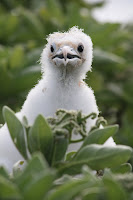Chesterfield Reef is a big V-shaped reef, right in the middle of precisely nowhere. Being almost exactly half way between Vanuatu and Bundaberg, it made a convenient spot to break up the trip. It tapers out to about 8 miles across at the top, and you can enter there and move down the V to get shelter from the SE trade winds. The water is a stunning postcard turquoise color and there are a few tiny white sand islands which are covered in nesting birds.
We were the only boat there for the two nights and the Chesterfields were just amazing, like something out of a nature documentary. The island we anchored off had a perpetual cloud of birds over it. Going ashore made the cloud even larger as hundreds of birds took wing and squawked at us. A thousand more of the smaller birds stayed on the ground guarding their eggs or fledglings. The small trees stand only 5 to 10 feet tall and are filled with gnarled branches, perfect for the nests of larger birds that fear that the crabs will eat theirs eggs or babies. Frigate birds and boobies nest in the trees.
The rocks and the sand above high tide are just packed with nesting boobies, gannets, terns & mollies, and they have no fear of humans - you can walk right up to them. Emily picked up one small bird that just calmly looked at her.
We spent most of the first day exploring the island but we had a problem with the dingy motor. It looked like a small clog in the dingy fuel line but the captain was nervous exploring too far from the mother ship. Ultimately, we decided we would take advantage of calm wind to make the final 3-day passage to Oz.
Tom



















2 comments:
Looks like an avian paradise!
Uncle Joe
Great Photos!
Post a Comment